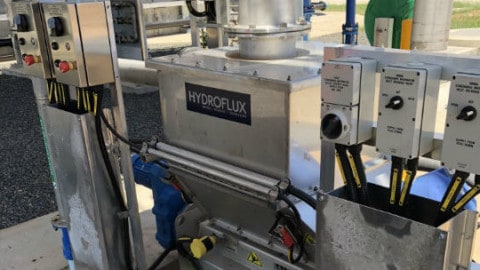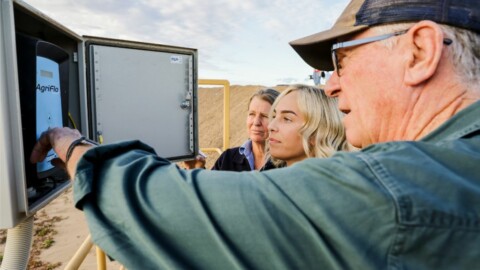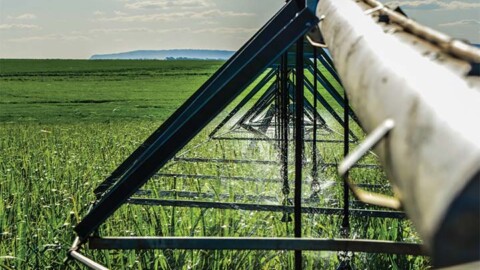By Ronaldt Vosloo, Vosloo Consulting Engineers; and the Department of Regional Development, Manufacturing and Water
With climate change causing an increase in extreme weather events – including floods, fires and drought – organisations and councils around Australia are repairing and upgrading pre-existing infrastructure to future-proof their communities. To help Southern Downs Regional Council (SDRC) improve drought resilience, the Queensland Government has invested $19.34 million to extend local water supplies, providing much needed water security to more than 24,000 residents in the region. The latest works completed under this funding are upgrades to the SDRC owned Leslie Dam Pump Station, including the replacement of three 55-year-old pumps.
In January 2020, Warwick was projected to run out of water by the end of the year with Leslie Dam down to less than 4.6 per cent capacity, creating a difficult and challenging time for the region. However, feasible solutions that could be delivered quickly were limited as water carting to a town the size of Warwick – which has a population of about 15,000 – is not viable.
While recent rain has bolstered short-term water supplies by filling both Leslie and Storm King Dams, historical data shows rain cannot always be relied on at the time of need, with this funding vital to providing drought resilience for Southern Downs’ drinking water supply.
The funding for the Queensland Government’s drought resilience package includes the following activities:
- Connection of a new bore at Warwick to the Warwick water supply system
- Recommission of the Allora bores, and in the longer term to the Toowoomba to Warwick Pipeline for treatment at the Warwick Water Treatment Plant
- Investigation into the potential use of Connolly Dam as a supplementary supply for Warwick without impacting Stanthorpe’s water security
- Upgrades to the Warwick Water Treatment Plant to treat blended water from various sources of supply
- Infrastructure to access remaining Leslie Dam dead storage by Sunwater
- Investigation into potential new local groundwater sources around Warwick, Stanthorpe and Yangan
- Investigation into the potential availability of water allocations in Leslie Dam for urban use has been completed by Sunwater
Accessing dead storage at Leslie Dam
One of the activities being undertaken as part of the drought resilience package is installing the infrastructure needed to access a portion of the water from Leslie Dam that was previously below the level of the pumps, and couldn’t be reached (dead storage).
Leslie Dam holds around 1,700 megalitres in its dead storage. By funding new capital works to access that water, the drought resilience package makes the best use of the Southern Downs’ locally available supplies and ensures as little water as possible is inaccessible, but allowing for some water to be left in the dam as per the Upper Condamine Water Supply Scheme Resource Operations Licence.
Works to access the dead storage – including upgrades to the Leslie Dam Pump Station – are being carried out by SDRC who is responsible for reticulated supply to its service areas, and Sunwater who owns Leslie Dam.
The $4.54 million upgrade to the Leslie Dam Pump Station was completed in December 2022 and in conjunction with a low level pumping station currently under investigation and in planning by Sunwater, it will enable SDRC to utilise the dead storage. The upgrade consisted of the replacement of three 55-year-old pumps, pipework and the electrical switchboard, with Vosloo Consulting Engineers (VCE) undertaking the design work.
Upgrading the Leslie Dam Pump Station
The Leslie Dam Pump Station was originally constructed in 1966 and employed three single stage horizontal split case centrifugal pumps (Pump Class EC) by Thompsons (Castlemaine). The 125HP pumps were installed in a parallel arrangement and operated in a duty/assist/standby mode.
The existing raw water transfer scheme involves pumping approximately 1,946m through a DN525 rising main from the Leslie Dam wall to a 118.39kL balance tank, before water flows under gravity head for approximately 7,427m to the water treatment plant in Warwick.
The original system resistance curves indicated nominal duty points of 67.82L/s at 80.77m head for a single pump operating, or 126.18L/s at 83.82m head for two pumps operating simultaneously.
The pumps are controlled by the water level in the balance tank via level sensors, control and SCADA systems. One of the original pumps failed in June 2018, which impacted on the ability of the remaining pumps to supply the water treatment plant.
The failed pump was removed and a temporary diesel backup pump installed in its place. The remaining two pumps delivered approximately 66L/s when a single pump was operating and 119L/s when both pumps were operating simultaneously.
SDRC indicated that winter demand in 2020 was approximately 120L/s, and summer demand approximately 160L/s. To keep up with current water demands the two remaining original pumps were both running as duty pumps, with the temporary diesel pump serving as a standby pump and to assist the existing pumps when demand was high.
Scope of service for the design work
Due to the age of the pumps and considering future demand, SDRC decided to upgrade the existing pumps and switchboard to ensure that the raw water supply to the water treatment plant is uninterrupted. SDRC appointed VCE to undertake the design required to upgrade the existing Leslie Dam Pumping Station.
VCE’s scope of services included the following:
- Undertaking hydraulic analysis and review of the existing pumping system to assess its hydraulic capacity to cater for current and future demands
- Estimating future demand flow rates to be used in the sizing and pump selection for the replacement pumps
- Do a pump selection for the replacement pumps
- Undertake hydraulic modelling and make recommendations regarding the suitability of the existing rising main and balance tank with regards to future demands
- Assess the existing power supply’s suitability for the proposed pump upgrade
- Prepare detailed design for the replacement of the existing pumps, control system and replacement of the existing Dall Tube (Venturi) type flow meter with an electromagnetic flow meter, including upgrade of the power supply
VCE appointed ECG Engineering (ECG) to undertake the electrical design, SafeGroup Automation (SGA) for the control and telemetry designs, and Minstaff Survey for the detail survey and 3D laser scan of the internal of the pump house.

Hydraulic options analysis
Preliminary pump selections were undertaken with the aim of designing a pumping system that can deliver a nominal pump rate of 243L/s, which is the 50-year (2070) Mean Day Maximum Month (MDMM) flow rate over 20 hours. Two pumping options were considered, option one being a duty/standby arrangement and option two being a duty/assist/ standby arrangement.
System resistance curves were developed for each of the two options, which included increased pipework sizes inside the pumping station, suitable to ensure flow velocities and friction head losses are acceptable and in accordance with adopted standards.
The pipe upgrades included increasing 5.83m of DN200 DICL suction pipework to DN450 DICL and DN375 DICL for options one and two respectively. The 1.56m length of DN200 DICL discharge pipework required upgrading to DN375 DICL and DN300 DICL for options one and two respectively.
VCE undertook a Net Present Value (NPV) analysis to quantify the most economical pump selection of the two options considered. The NPV analysis was undertaken for a 50-year period. The duty/assist/standby arrangement (option two) with 160kW pumps proved to be the most economical pump selection according to the NPV analysis results and energy cost estimates.
It was anticipated that the construction cost for option two would be higher than for option one, but the pumps will operate closer to the best efficiency point (BEP), resulting in lower operating cost over the life of the asset.
Option two can also supply a wider flow range than option one, starting from approximately 70L/s at 80.36m head (at 47Hz) with one pump being operational, to approximately 247L/s at 88.36m head (at 50Hz) with two pumps being operational simultaneously, for the dam mean water level (MWL) scenario.
The duty/standby 315kW pump selection (option one) can deliver a flow range in the order of 165L/s at 83.20m head (at approximate frequency 47.9Hz) to 243L/s at 86.87m head (50Hz) for one pump being operational and dam MWL. SDRC approved VCE’s proposal to proceed with the detailed design of the duty/assist/standby arrangement and the horizontal split case centrifugal pumps with 160kW motors.

Pump selection
Three Grundfos type LS horizontal split case centrifugal pumps (Model LS200-150-508B) with 485.2mm diameter impellers and 160kW motors were selected for a duty/assist/standby arrangement, to operate at a nominal duty point of 153L/s at 83.23m head with 82.6 per cent pump efficiency, for the dam MWL scenario and single pump operation at full speed (50Hz).
Two pumps operating simultaneously in a parallel arrangement were estimated to have a nominal duty point of 247L/s at 88.36m head with 81.9 per cent pump efficiency, for the dam MWL scenario and full pump speed. The pumps will be controlled with Schneider Electric’s model floor-standing model Altivar Process ATV650C20N4F Variable Speed Drives (VSD).
The electrical mains cables between the existing 500kVA transformer and the main switchboards needed to be upgraded to prevent overloading during pumping above the nominal pump duty point. The 500kVA transformer and mains cable, as well as the main switchboards were replaced as part of the pump station upgrade.
The pump selection was undertaken with the intent of delivering the nominal pump rate of 243L/s at dam MWL and two pumps operating simultaneously, not for the worst case – dam bottom water level (BWL) scenario. This was done to reduce the power loading on the existing 500kVA transformer and avoid the need for upgrading the same.
The disadvantage of this approach is that for the dam BWL scenario, the proposed pumping system will be limited to deliver a maximum flow rate of approximately 106L/s for dual pump operation at full speed (50Hz). SDRC is currently working with Sunwater and the Queensland Government to design a low level pumping station that will enable it to utilise water below the pumps’ BWL, the remainder of the ‘dead storage’.
The low level pump station will be additional to the existing Leslie Dam Pump Station, and will enable the new 160kW pumps to deliver the full 50-year planning horizon flow rate of 243L/s at dam BWL and lower water levels. This investigation and planning work into a ‘dead storage pumping station’ are currently being undertaken by Sunwater as part of the Queensland Government’s drought resilience package.
Balance tank storage
VCE’s analysis of the pumping system confirmed that the balance tank storage volume is sufficient for the existing and proposed pumping systems if it is setup and operated in accordance with its original design intent, which is not to provide raw water storage, but only as a small holding facility to utilise the available gravity head between the balance tank and the water treatment plant.
The purpose of the balance tank is to limit pumping to it, and thereby minimise pumping costs. Adjustment to the pump stop and start level within the balance tank was proposed to reduce the number of pump starts and minimise pumping time (and power costs).
Construction phase
SDRC appointed Repump for the replacement pumps, VSDs and switchboard, including pipework, valves and fittings inside the pump house, and installation of a DN500 flowmeter and isolation valves in the existing DN525 MS pressure main outside the pump house.
Repump was also responsible for design and installation of a bypass pumping system that would maintain pumping operations while replacing the civil, electrical and control equipment.
Ergon Energy was responsible for installation of a new 500kVA pole-mounted transformer adjacent to the pump house. Repump also installed a new hoist and hoist beam inside the pump house as part of their contract with SDRC.
Next phase of works to secure water supply
Works are continuing on other projects to secure the region’s water supply funded by the Queensland Government, including the construction of a pipeline to connect a new bore near Warwick to augment its water supply network, and recommissioning its Allora bores for supply to Council’s construction purposes in the short term and connection to the Toowoomba to Warwick Pipeline in the long term.
The Queensland Government has invested more than $380 million for the construction of the Toowoomba to Warwick Pipeline project, which forms part of its wider commitment to providing long-term water security for the region.

With an expected completion date of early 2027, the Toowoomba to Warwick Pipeline pipeline will transfer water from Wivenhoe Dam when needed, to ensure a drought contingency water supply to 24,000 Southern Downs residents (which includes contingency supply for water carting to Stanthorpe when required), and a permanent water supply to 3,400 residents in the Toowoomba Regional Council towns of Cambooya, Greenmount, Nobby and Clifton along the Pipeline route.
The drought resilience package funding also allows SDRC to upgrade the Warwick Water Treatment Plant so that it can effectively blend, treat and distribute all of the new (and existing) water sources available to Council.
Getting the best use from its locally available water sources not only gives the Council more water – it also contributes to reducing Council’s demand on the Toowoomba to Warwick Pipeline, and hence the costs for operating the pipeline.
The Queensland Government will continue working closely with Seqwater and the Southern Downs and Toowoomba Regional Councils to optimise the operation of the Toowoomba to Warwick Pipeline, keeping costs low for the Southern Downs without impacting Toowoomba’s water security.
The Southern Downs drought resilience package and the Toowoomba to Warwick Pipeline will create 460 local jobs, and deliver on the Queensland Premier’s November 2019 commitment that Queensland families will not run out of drinking water.



















Comments are closed.
I see you have four other magazines, can I get digital copies of those also?
Hi Jack,
Thank you so much for your interest in Pump Industry Magazine.
Digital copies of all of our previous issues can be found on our website here: https://www.pumpindustry.com.au/digital-magazine-archive/#1523424366323-3939de74-3607
We release new editions quarterly and have just launched our Winter 2023 edition, which you can read via the link.
If there is anything else we can help with, let us know.